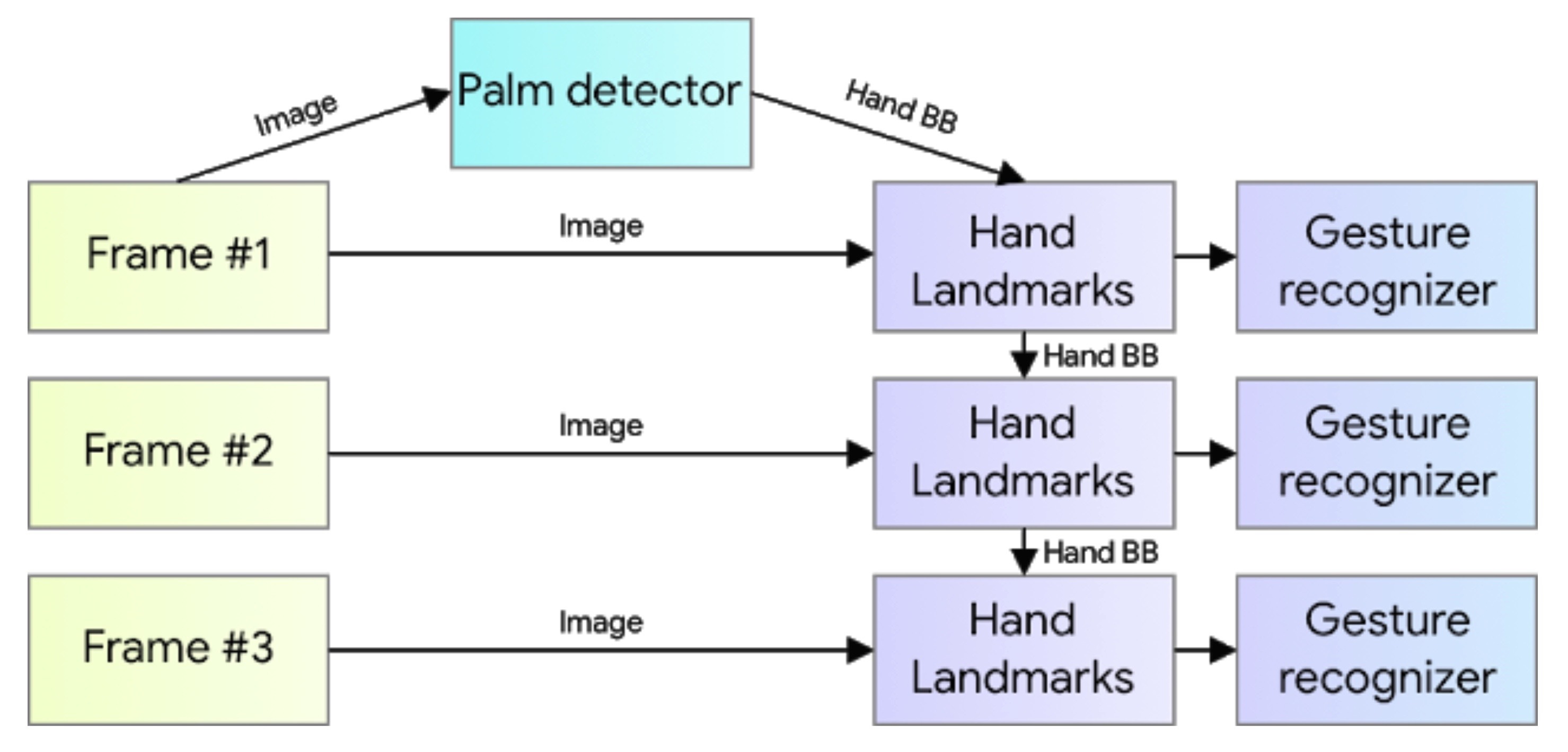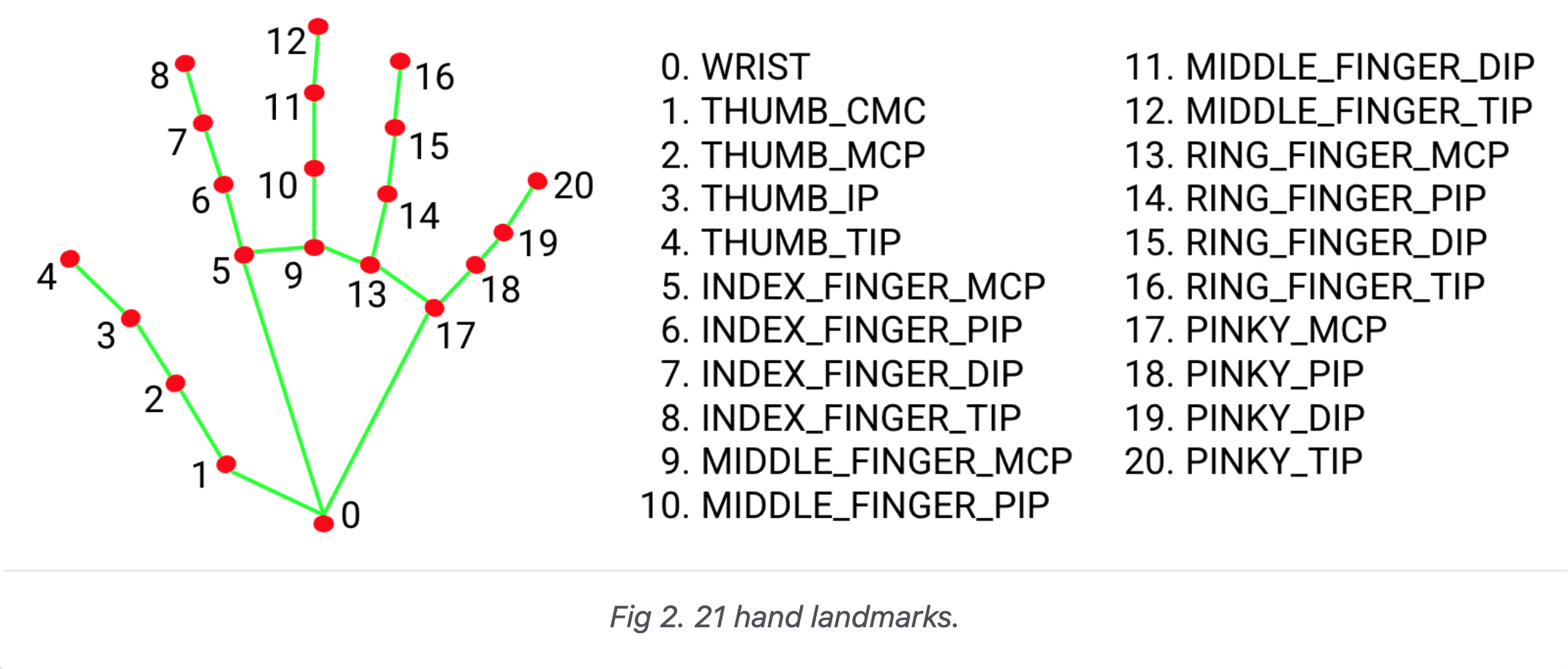Mediapipe: https://github.com/google/mediapipe
MediaPipe Hand: https://google.github.io/mediapipe/solutions/hands
MediaPipeはBazarevskyらがCVPR2019で発表したオープンソースの機械学習用フレームワークで,そこで用いられている手認識機能は,single-shot手のひら認識アルゴリズムとlandmark認識モデルが組み合わされたものです(Google AI Blog: On-Device, Real-Time Hand Tracking with MediaPipe)
手の形状は以下の各ランドマークの座標として取得できます.毎フレーム推論が走り,cv座標での値が取得できます.
返ってくるlandmarkのオブジェクトは以下のようにして座標のfloatが取り出せます
for hand_idx, landmarks in enumerate(multi_hand_landmarks): for point_idx, points in enumerate(landmarks.landmark): print(f"Hand: {hand_idx}, {HAND_LANDMARK_NAMES[point_idx]}," + f"x:{points.x} y:{points.y} z:{points.z}")
この時のHAND_LANDMARK_NAMESは,以下のような順番になっています.
HAND_LANDMARK_NAMES = [ "wrist", "thumb_1", "thumb_2", "thumb_3", "thumb_4", "index_1", "index_2", "index_3", "index_4", "middle_1", "middle_2", "middle_3", "middle_4", "ring_1", "ring_2", "ring_3", "ring_4", "pinky_1", "pinky_2", "pinky_3", "pinky_4" ]
今回はこのMediaPipeによるリアルタイム手認識を用いて何かしらのインタラクティブ作品やWekinator等を用いるジェスチャ認識などのためのOpen Sound Controlでのデータ送信をプロトタイプします.
スクリプト
# Atsuya Kobayashi 2020-12-22 # Reference: https://google.github.io/mediapipe/solutions/hands # LICENCE: MIT from itertools import chain import mediapipe as mp from cv2 import cv2 from pythonosc import udp_client IP = "127.0.0.1" PORT = 7474 VIDEO_DEVICE_ID = 0 RELATIVE_AXIS_MODE = True HAND_LANDMARK_NAMES = [ "wrist", "thumb_1", "thumb_2", "thumb_3", "thumb_4", "index_1", "index_2", "index_3", "index_4", "middle_1", "middle_2", "middle_3", "middle_4", "ring_1", "ring_2", "ring_3", "ring_4", "pinky_1", "pinky_2", "pinky_3", "pinky_4" ] def extract_detected_hands_points(multi_hand_landmarks, send_osc_client=None): if multi_hand_landmarks is not None: for hand_idx, landmarks in enumerate(multi_hand_landmarks): for point_idx, points in enumerate(landmarks.landmark): # if you want to check data on console print(f"Hand: {hand_idx}, {HAND_LANDMARK_NAMES[point_idx]}," + f"x:{points.x} y:{points.y} z:{points.z}") """ if you want to send data to addresses correspoding to landmarks names on detected hands, use berow """ # if send_osc_client is not None: # send_osc_client.send_message(f"/{HAND_LANDMARK_NAMES[point_idx]}", # [points.x, points.y]) """if you want to send data to single input address, use berow""" if send_osc_client is not None: send_osc_client.send_message( f"/YOUR_OSC_ADDRESS", list(chain.from_iterable([[p.x, p.y] for p in landmarks.landmark]))) if __name__ == "__main__": mp_drawing = mp.solutions.drawing_utils mp_hands = mp.solutions.hands hands = mp_hands.Hands( min_detection_confidence=0.5, min_tracking_confidence=0.5) cap = cv2.VideoCapture(VIDEO_DEVICE_ID) osc_client = udp_client.SimpleUDPClient(IP, PORT) while cap.isOpened(): success, image = cap.read() if not success: print("Ignoring empty camera frame.") # If loading a video, use 'break' instead of 'continue'. continue image = cv2.cvtColor(cv2.flip(image, 1), cv2.COLOR_BGR2RGB) image.flags.writeable = False results = hands.process(image) extract_detected_hands_points(results.multi_hand_landmarks, send_osc_client=osc_client) image.flags.writeable = True image = cv2.cvtColor(image, cv2.COLOR_RGB2BGR) if results.multi_hand_landmarks: for hand_landmarks in results.multi_hand_landmarks: mp_drawing.draw_landmarks( image, hand_landmarks, mp_hands.HAND_CONNECTIONS) cv2.imshow('Detected Hands', image) if cv2.waitKey(5) & 0xFF == 27: break hands.close() cap.release()

